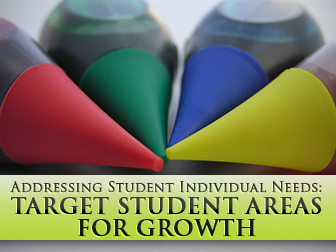Addressing Student Individual Needs: (But How do You Even Know What They Are?): Methods to Target Student Areas for Growth


The most important thing students can do is keep their head in the game and persevere through days when speaking a second language is profoundly frustrating. To prevent students from giving up or feeling overwhelmed it’s essential to keep track of progress and let students know when they have stepped up to the next level of achievement. If a student has a hard time, they can look back at their progress sheet and compare their skills from that time to their current ability. Tracking progress is one of the best motivational tools available to students and teachers.
It’s important for students to keep all of their notes even if that means having binders for multiple years. When students are starting to feel their motivation slip away, they can look back at the previous semester or year and see how far they’ve come. The teacher can go over a portion of the notes and show students specifically where they've improved. They can look at the subject-verb agreement, clarity and concision, or just overall improvement. If a teacher thinks their students will throw notes away, it's a good idea to keep samples from throughout the year.
The long-term goal is to become conversational and then fluent. However, this will leave students working towards something they won't achieve for many months. It’s beneficial to set short-term goals where students can track their progress in real time. For example, maybe they can successfully order a cup of coffee at the local cafe or read and comprehend a chapter book written in English. Short-term goals keep students motivated.
It's also important for students to be able to track major achievements. The first time they're able to write a whole paragraph in English is a really big deal. The first time they have a fruitful conversation with a native speaker should be celebrated. Some students may be hesitant to mention that they’ve reached a new goal, or they may simply not notice it. If teachers can track their student’s benchmarks, creating a makeshift timeline, they can go over this with their students each semester and discuss genuine progress.
Most ESL students are anxious about talking aloud. However, this is the only way they'll become conversational. If possible, the instructor can record their student’s voices and compare it from month to month. Students who are shy, but hear an improvement, will be more motivated to continue with their studies.
It's also beneficial to track a student's grammar skills. At first an essay might be challenging to read and understand but, over time, it will become readable and then fluent. Each will struggle with one or two specific elements, so if the instructor can identify the issue and track the progress over time, they can share this information with students and continuously adjust learning goals.
One of the biggest ways to track progress is through real life situations. When students first start their English language adventures, they may not be able to get around without the help of a native speaker. However, once they can order lunch by themselves or get their shopping done without help, they have experienced an everyday situation that makes their life a lot easier. If students are getting frustrated, the instructor can bring up the fact that they weren't able to order a cup of coffee six months ago and now they can order breakfast, lunch, and dinner.